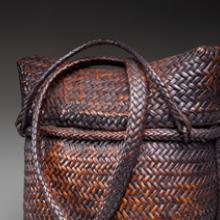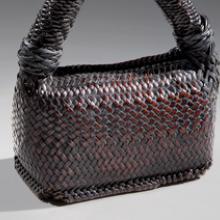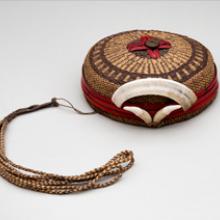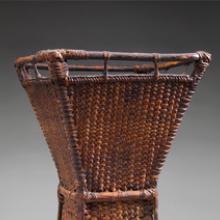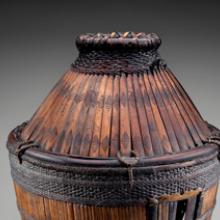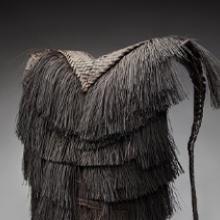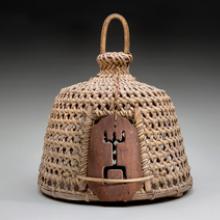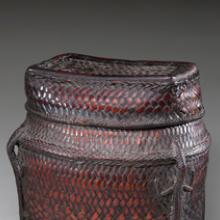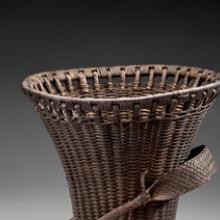International Terminal
International Terminal
Departures - Level 3
July 2013 - January 2014











Backpack with lid (sangi) 20th century
Bontoc
Luzon Cordillera, Philippines
plaited construction
rattan
Fowler Museum at UCLA; Anonymous gift
X86.3364a,b
L2013.0801.049a,b
The Bontoc sangi, a plaited backpack with a lid, features a heavy, rattan shoulder strap. Men normally use the sangi for carrying a wide variety of items: rice, meat, beans, lunch, tools, and even on occasion, small children. Due to its versatility, Cordillera men find it especially handy for carrying needed items when going on trips or to work.
Basket for roasted unripe rice (kulikug) 20th century
Bontoc
Luzon Cordillera, Philippines
plaited construction
bamboo, rattan
Fowler Museum at UCLA; Gift of Helen and Dr. Robert Kuhn
X78.2265
L2013.0801.021
This uniquely shaped basket is designed to store roasted green rice, a popular snack. Rice grains are harvested before fully ripened while still soft. Next, they are roasted and pounded in the rice mortar to remove the hull. This flattens the soft grain, which is eaten without cooking. The closed form of the basket helps to keep the grains soft, as they quickly harden with exposure to air.
Woman’s basket and rain cape (tudung) 20th century
Ifugao
Luzon Cordillera, Philippines
sewn construction
pandanus leaf, rattan
Fowler Museum at UCLA; Gift of Helen and Dr. Robert Kuhn
X78.2336
L2013.0801.034

Women in many parts of Luzon use a trough-shaped carrying basket or tudung constructed of a layer of pandanus leaves (ga-ad in Ifugao) sandwiched between inner and outer frameworks of rattan. The basket doubles as a rain cape when worn over the head due to its thick waterproof layers.
In most places in the Cordillera, women are primarily responsible for planting and transplanting rice, weeding, and harvesting. Tudung are particularly useful for transporting wet rice seedlings at transplanting time. These baskets are also made in smaller sizes for carrying a variety of produce.
Hat (soklong) 20th century
Bontoc
Luzon Cordillera, Philippines
twined construction
rattan, boars’ teeth, dogs’ teeth, vegetable fiber
Fowler Museum at UCLA; Bequest of Alan Rose
X96.5.53
L2013.0801.059
Various types of basketry hats indicate social status and group affiliation. The colorful Bontoc bachelor’s hat is made with red-eyed rattan or fabric and decorated with boars’ tusks, dogs’ teeth, and chicken feathers.
Carrying basket for sweet potatoes (balyag) 20th century
Ifugao
Luzon Cordillera, Philippines
plaited construction
rattan
Fowler Museum at UCLA; Gift of Helen and Dr. Robert Kuhn
X78.2245
L2013.0801.015
While rice is the most prestigious staple and ritual food in the Cordillera, sweet potatoes, or camotes, provide food for the majority of the population. More easily cultivated than rice, sweet potatoes can grow almost anywhere. They provide sustenance for people and domestic animals. Leaves of sweet potato vines and parings are boiled and fed to hogs. In Ifugao, about twenty to thirty varieties of sweet potatoes are cultivated. Although plentiful, they are not considered a high-status food or revered in the same manner as rice.
Women transport extremely heavy loads of sweet potatoes home from the fields in baskets supported by a strap worn across the forehead. The Ifugao sweet potato basket or balyag, would have originally had a forehead strap, but the handy device is often removed when baskets enter the collectors’ market.
Locust storage basket (iwus) 20th century
Bontoc
Luzon Cordillera, Philippines
twined construction
bamboo, rattan
Fowler Museum at UCLA; Gift of the Rogers Family Foundation
X86.3272
L2013.0801.047
Like edible snails, locusts were traditionally considered a delicacy in the Cordillera. In the past, swarms of locusts frequently appeared in the highlands. Armed with nets, men, women, and children would capture the insects. The locusts were kept alive in jar-like baskets with open-slatted sides or net-like bottoms for ventilation. Locusts were then roasted or boiled and the insects’ wings and legs removed; finally, they might be dried in the sun. This Bontoc iwus has tightly-slatted sides with ventilation provided at the top of the basket.
Hunter’s backpack (inabnūtan) 1982
Ifugao
Luzon Cordillera, Philippines
plaited construction
rattan, abnut fiber from the bangi palm
Fowler Museum at UCLA; Promised gift of the Rogers Family Foundation
X82.1524
L2013.0801.046
Basketry containers historically played an indispensable role not only in agriculture, but also hunting and gathering. Hunters embarked on their expeditions with plaited backpacks. One version of the Ifugao backpack, called inabnūtan, is covered with a thick overlay of palm fibers that repel rain. On the outbound journey, the pack held the hunter’s provisions, including, perhaps, a jar of rice beer with which to make an offering to insure a successful hunt. If luck and skill prevailed, the men returned to the village with their packs filled with meat.
Chicken coop (ubi) 20th century
Ifugao
Luzon Cordillera, Philippines
plaited construction
rattan, wood
Fowler Museum at UCLA; Anonymous gift
X91.5694
L2013.0801.055
 Baskets used in the Cordillera often protect and transport domestic animals. Commonly raised animals in the region include chickens, pigs, goats, and cattle. Chickens and pigs, considered the most important of these animals, are carefully tended. Among the Ifugao, for example, the owner knows every single chicken in his flock. Chickens roam freely during the day; but at night, their owners gather them in special basketry coops called ubi . They hang the basketry coops high above the ground under the eaves of the house to protect the chickens from rats, cats, and thieves.
Baskets used in the Cordillera often protect and transport domestic animals. Commonly raised animals in the region include chickens, pigs, goats, and cattle. Chickens and pigs, considered the most important of these animals, are carefully tended. Among the Ifugao, for example, the owner knows every single chicken in his flock. Chickens roam freely during the day; but at night, their owners gather them in special basketry coops called ubi . They hang the basketry coops high above the ground under the eaves of the house to protect the chickens from rats, cats, and thieves.
Basket (kamuwan) 20th century
Kankanay
Luzon Cordillera, Philippines
plaited construction
bamboo, rattan
UCLA Museum of Cultural History; Museum purchase with Manus Fund
X82.1221a,b
L2013.0801.045a,b
After rice is processed, it is either cooked in boiling water or stored for later use. This Kankanay kamuwan has lizard-shaped handles, a decorative touch widely copied in recent years by basket makers in the commercial trade. A kamuwan of this size can hold more rice than is needed for daily consumption; so it most likely was used in preparation for a celebration involving many guests.
[from left to right]
Sieve for rice beer (gūbun di bayah) 1978
Ifugao
Luzon Cordillera, Philippines
plaited construction
bamboo
Fowler Museum at UCLA; Gift of Helen and Dr. Robert Kuhn
X78.2180
L2013.0801.003
Jar for rice beer 20th century
China or Japan
ceramic
Fowler Museum at UCLA; Gift of Jovita Luglug
X97.40.1
L2013.0801.060
Jar for rice beer (hinoghogan) 20th century
Ifugao
Luzon Cordillera, Philippines
plaited construction
clay, rattan, wood
Fowler Museum at UCLA; Museum purchase
X76.1065a,b
L2013.0801.002a,b
An important part of religious rituals and agricultural festivities, rice beer is made from glutinous rice and yeast. Approximately fifteen bundles of rice are required to make a batch of rice beer that will fill a medium-size ceramic jar. After the grain is threshed, hulled, and winnowed, it is toasted in an iron vat over an outdoor fire. The rice is then transferred to basketry trays, the vat filled with water, and the rice poured back in to boil. A yeast ball made from crushed plant roots is mixed into the warm, cooked rice and spread out in winnowing trays. The mixture is then transferred to a basket or trough lined with banana leaves and sealed for initial fermentation. After three days, the mash and fermented liquids are transferred to ceramic jars and covered tightly with banana leaves. Once five or six days have passed, the beer may be moved to smaller containers.
Carrying basket for sweet potatoes (kayabang) 20th century
Ibaloi
Benguet, Luzon Cordillera, Philippines
plaited construction
rattan, wood
Fowler Museum at UCLA; Gift of Helen and Dr. Robert Kuhn
X78.2320a,b
L2013.0801.029a,b

